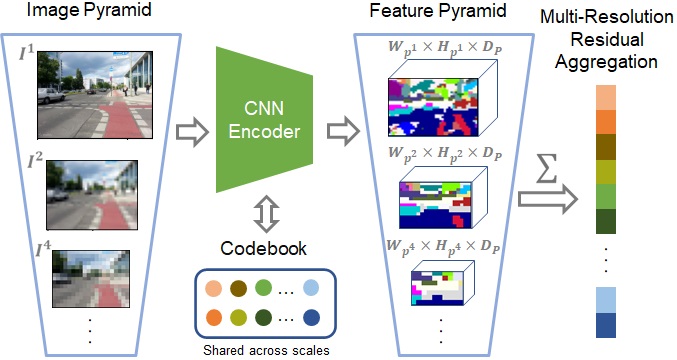This repository contains code for the RAL2022+ICRA2022 paper "MultiRes-NetVLAD: Augmenting Place Recognition Training with Low-Resolution Imagery"
The article can be found on arXiv and the official proceedings.
When using code within this repository, please refer the following paper in your publications:
@article{khaliq2022multires,
title={MultiRes-NetVLAD: Augmenting Place Recognition Training with Low-Resolution Imagery},
author={Khaliq, Ahmad and Milford, Michael J and Garg, Sourav},
journal={IEEE Robotics and Automation Letters},
year={2022},
publisher={IEEE},
volume={7},
number={2},
pages={3882-3889},
doi={10.1109/LRA.2022.3147257}
}
This repository is based on PyTorch NetVLAD github, please follow its installation section. The user is advised to install wandb python package and make an account/project on wandb.
Here, the main.py contains the majority of the code, and has three different modes (train, test, cluster)
To initialise the MultiRes-NetVLAD layer, it is required to first run main.py with the correct settings and --mode=cluster.
python main.py --mode=cluster --arch=vgg16-12 --pooling=netvlad --density_L=10 --num_clusters=64Once the clusters are stored, the MultiRes-NetVLAD model can be trained using (the following default flags):
python main.py --mode=train --arch=vgg16-12 --pooling=netvlad --density_L=10 --num_clusters=64For more information on all commandline arguments run:
python main.py --helpThis repository also contain Patch-NetVLAD code. After the successful training of MultiRes-NetVLAD, PCA-Whitening layer can be added using add_pca.py. The user needs to set parameters in train.ini in configs folder inside patchnetvlad. The user is required to set 'resumepath', 'density_L', 'dataset' and so on. By default, it is configured to train the PCA-Whitening layer of L=10 MR-NetVLAD on pittsburgh dataset. When executed with correct settings, this will add an additional checkpoint file to the same folder as resume_path.
python add_pca.py
The user is advised to download the L=10 MR-NetVLAD model states from checkpoint. To test the pretrained MR-NetVLAD (PCA-Wht) model on the Pittsburgh 30k testset (split can be 'test', 'val', 'val250k' and 'test250k'):
python main.py --mode=test --resume=./code_outputs/runs/vgg16-12_L_10_netvlad_pittsburgh_cluster64_trim-2/ --dataset=pittsburgh --split=test --appendPcaLayerInside the precomputed_results folder, predictions and recall values for NetVLAD or L=1 MR-NetVLAD, L=10 MR-NetVLAD and other VPR techniques reported in the paper are provided.
